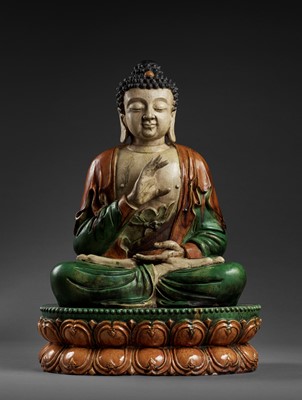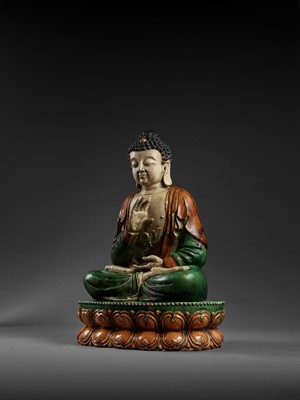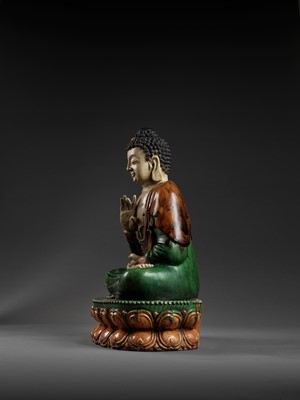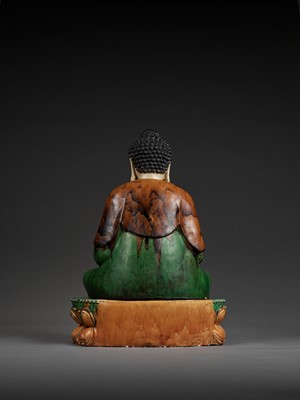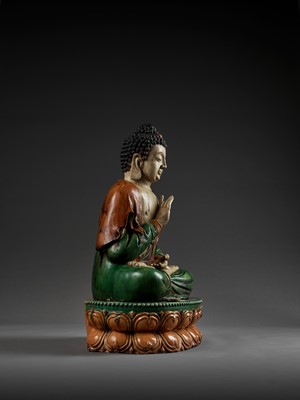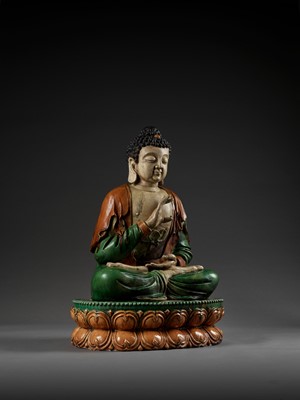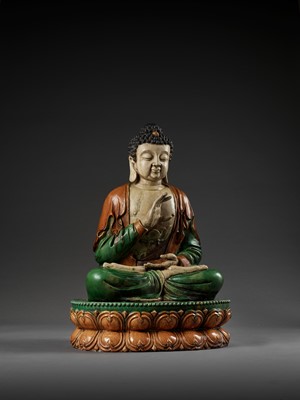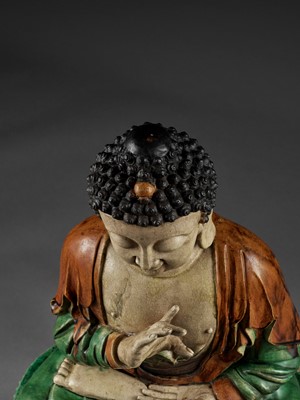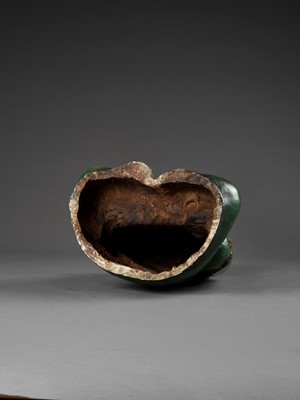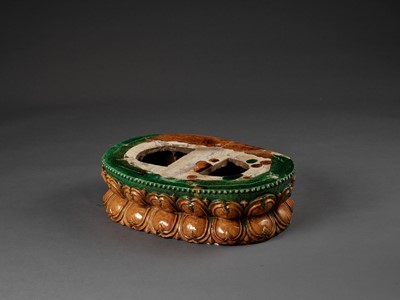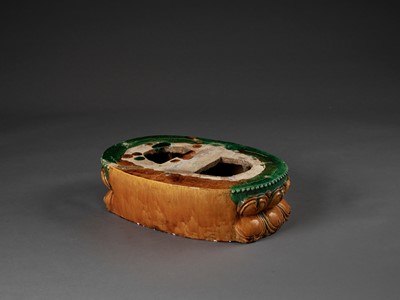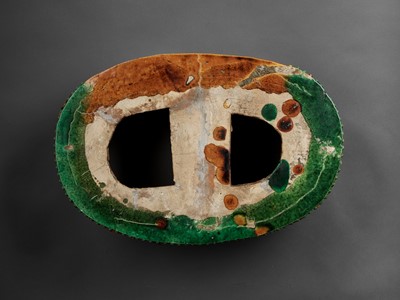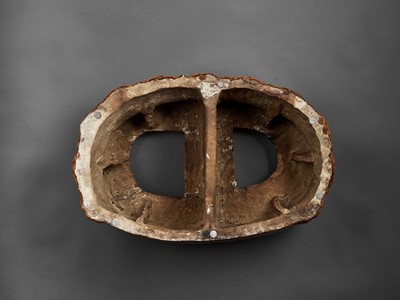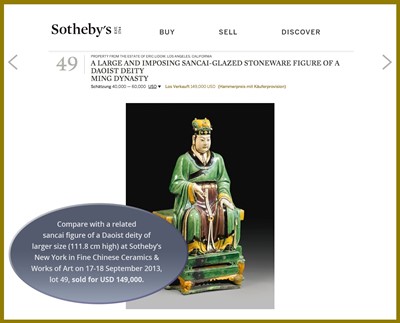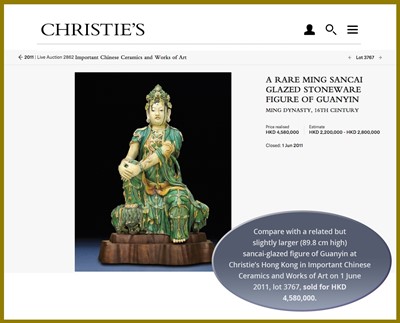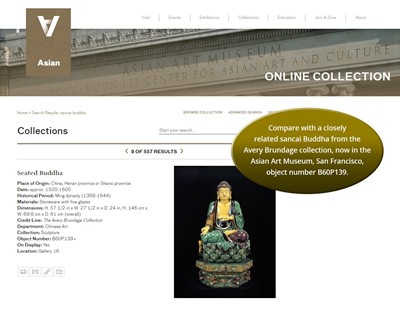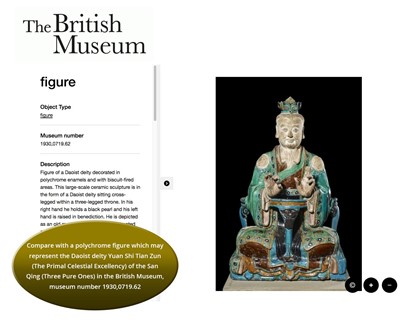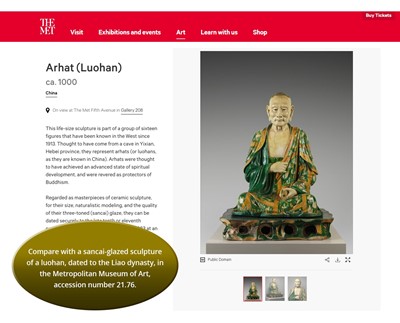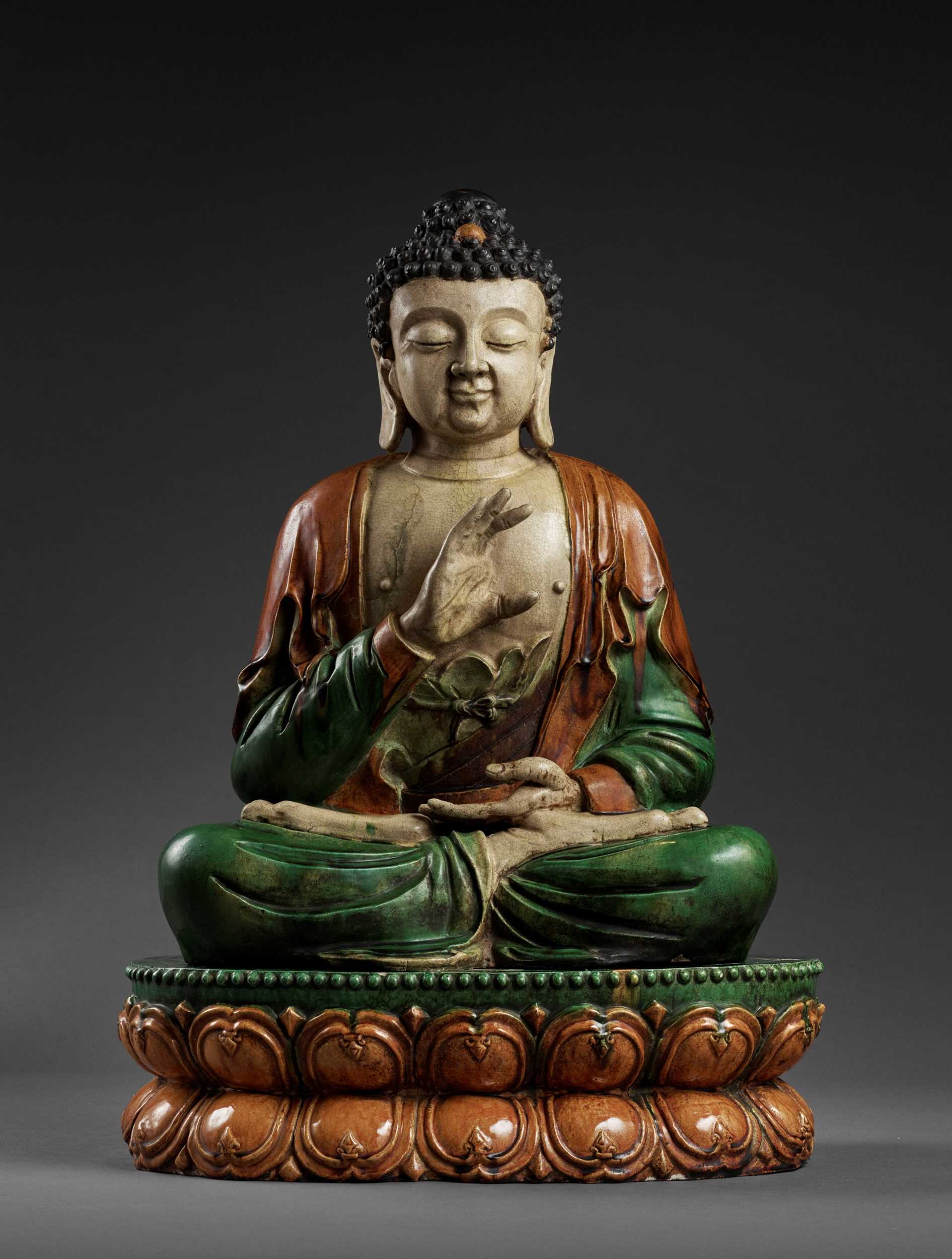5th Mar, 2021 10:00
TWO-DAY AUCTION - Fine Chinese Art / 中國藝術集珍 / Buddhism & Hinduism
140
A MONUMENTAL SANCAI-GLAZED FIGURE OF BUDDHA SHAKYAMUNI, MING DYNASTY
明代三彩釋迦牟尼坐蓮像
Sold for €126,400
including Buyer's Premium
China, Henan province or Shanxi province, 1368-1644 (ca. 1500-1600). Seated in dhyanasana on a matching, separately fired double-lotus base with beaded edge. His left hand is raised in front of the chest and his right lowered on his lap, wearing a loose-fitting monastic robe opening at the chest. The serene face with downcast eyes and full lips forming a benevolent smile, flanked by long pendulous earlobes, the hair in tight curls surmounted by a domed ushnisha.
Provenance: From a Swedish private estate.
Condition: Excellent condition with old wear and firing flaws, including a glaze recess to one hand. A major firing crack to the base was sealed at the time of production, with associated superficial recesses that look similar to firing cracks but are in fact glaze recesses. Minor chips and losses along the edge of the base, intentional glaze crackling, extensive weathering to glaze areas resulting in some sections being slightly dull. Note that for a sancai statue of this size and age, the present condition must be considered as superb.
Weight: 44 kg
Dimensions: Height 83.5 cm (measured including the matching lotus base, the Buddha alone measuring already 67 cm height)
Both Buddhist and Daoist sancai-glazed stoneware figures were popularly commissioned during the Ming dynasty. They were likely inspired by the famous Yixian glazed pottery luohans, discovered before World War I in caves at Yizhou and described as one of the most important groups of ceramic sculpture in the world.
No other sancai-glazed figures of Buddha, with such fine modeling, in equally well-preserved condition, and of this date and size, appear to have been published in private collections.
A sancai-glazed seated figure of Buddha is illustrated by Rene-Yvon Lefevre d'Argence, Chinese, Korean and Japanese Sculpture from the Avery Brundage Collection, Kondasha, Tokyo, 1974, fig. 170. In the catalog description, the author writes, “The figure belongs to a large series, many of which have reportedly come from Shansi, and is very close to a Buddha now in the Musée Guimet. The Avery Brundage Collection example seems to continue the style of a pottery Buddha, dated 1494, in the Metropolitan Museum of Art.” The dated figure in the Metropolitan Museum is illustrated by W. Cox, The Book of Pottery and Porcelain, Vol. 1, New York, 1947, pl. 151.
Literature comparison: Compare with a closely related sancai Buddha from the Avery Brundage collection, now in the Asian Art Museum, San Francisco, object number B60P139. Compare with a sancai-glazed sculpture of a luohan, dated to the Liao dynasty, in the Metropolitan Museum of Art, accession number 21.76. Compare also with a polychrome figure which may represent the Daoist deity Yuan Shi Tian Zun (The Primal Celestial Excellency) of the San Qing (Three Pure Ones) in the British Museum, museum number 1930,0719.62. Further Daoist examples include a figure of the Heavenly Marshal Zhao, dated 1482 in the Metropolitan Museum of Art, New York and another related seated figure of the Daoist God of Literature, Wenchang Wang in the Royal Ontario Museum is illustrated in Henry Trubner, Royal Ontario Museum, The Far Eastern Collection, Toronto, 1968, p. 72, no. 90.
Auction result comparison: Compare with a related sancai figure of a Daoist deity of larger size (111.8 cm high) at Sotheby’s New York in Fine Chinese Ceramics & Works of Art on 17-18 September 2013, lot 49, sold for USD 149,000. Compare also with a related but slightly larger (89.8 cm high) sancai-glazed figure of Guanyin at Christie’s Hong Kong in Important Chinese Ceramics and Works of Art on 1 June 2011, lot 3767, sold for HKD 4,580,000.
明代三彩釋迦牟尼坐蓮像
中國,河南省或山西省,1368-1644 (約 1500-1600)年。釋迦牟尼結跏趺坐坐在匹配但分開燒製的寶珠紋雙層蓮座上。他的左手在胸前舉起,右手擱在膝上,身著寬鬆敞胸袈裟。寧靜的臉龐,雙眼微垂,嘴唇豐滿,露出仁慈的笑容。臉部兩側是長長的耳垂,頭頂頭髮捲曲,有螺髻。
來源:瑞典私人遺產
品相:狀況極佳,有舊磨損和燒製瑕疵,包括一隻手上有釉面凹陷。底座一條燒製裂紋已在製作時經過修補,相關的表面凹陷,看起來類似燒裂,但實際上是釉面凹陷。底座邊緣有細小碎屑和缺損,釉面開裂,釉面區域有廣泛風化導致某些斷面有些暗沉。請注意,像這樣的尺寸和年代的三彩造像,當前狀況算是保存相當好的。
重量:44公斤
尺寸:高 83.5 厘米 (含蓮座,佛像高67 厘米)
在明代,佛教和道教的三彩釉陶器都極受推崇,可能是受到著名的易縣三彩羅漢的啟發,它們是在一戰前在易州發現的,是世界上最重要的陶瓷造像群之一。
在私人收藏中的同期且相近尺寸的三彩造像沒有任何一座保存如此完整。
一件三彩坐佛見 Rene-Yvon Lefevre d'Argence所著的Chinese, Korean and Japanese Sculpture from the Avery Brundage Collection, 東京講談社 1974年出版,圖 170。在畫冊中,作者寫道 “The figure belongs to a large series, many of which have reportedly come from Shansi, and is very close to a Buddha now in the Musée Guimet. The Avery Brundage Collection example seems to continue the style of a pottery Buddha, dated 1494, in the Metropolitan Museum of Art.”(該造像屬於一個造像系列,其中很多據報導自山西省,與現在吉美美術館中的佛像非常接近。Avery Brundage 收藏的例子似乎延續了大都會博物館中一座1494年的陶佛的風格。)大都會博物館中的陶佛可見W. Cox, 畫冊The Book of Pottery and Porcelain, 第一冊,紐約1947年, 圖151。
文獻比較:一件來自Avery Brundage collection相近三彩佛像,現存於舊金山亞洲藝術博物館,編號 B60P139;一件遼代三彩羅漢,大都會博物館,編號 21.76. ;一件粉彩元始天尊見大英博物館,編號1930,0719.62. 其他道教造像如1482年的趙公明像見紐約大都會博物館管,多倫多皇家安大略博物館的文曲星造像可見Henry Trubner所著的Royal Ontario Museum, The Far Eastern Collection, 多倫多1968年, 72頁, 90號。
拍賣結果比較:一件三彩道教人物造像 (高111.8 厘米) 見紐約蘇富比 Fine Chinese Ceramics & Works of Art 拍場2013年9月 17-18日 lot 49, 售價 USD 149,000. 一件相近但更大 (高89.8厘米)的三彩觀音像見香港佳士得Important Chinese Ceramics and Works of Art 拍場2011年6月1日 lot 3767, 售價 HKD 4,580,000.
China, Henan province or Shanxi province, 1368-1644 (ca. 1500-1600). Seated in dhyanasana on a matching, separately fired double-lotus base with beaded edge. His left hand is raised in front of the chest and his right lowered on his lap, wearing a loose-fitting monastic robe opening at the chest. The serene face with downcast eyes and full lips forming a benevolent smile, flanked by long pendulous earlobes, the hair in tight curls surmounted by a domed ushnisha.
Provenance: From a Swedish private estate.
Condition: Excellent condition with old wear and firing flaws, including a glaze recess to one hand. A major firing crack to the base was sealed at the time of production, with associated superficial recesses that look similar to firing cracks but are in fact glaze recesses. Minor chips and losses along the edge of the base, intentional glaze crackling, extensive weathering to glaze areas resulting in some sections being slightly dull. Note that for a sancai statue of this size and age, the present condition must be considered as superb.
Weight: 44 kg
Dimensions: Height 83.5 cm (measured including the matching lotus base, the Buddha alone measuring already 67 cm height)
Both Buddhist and Daoist sancai-glazed stoneware figures were popularly commissioned during the Ming dynasty. They were likely inspired by the famous Yixian glazed pottery luohans, discovered before World War I in caves at Yizhou and described as one of the most important groups of ceramic sculpture in the world.
No other sancai-glazed figures of Buddha, with such fine modeling, in equally well-preserved condition, and of this date and size, appear to have been published in private collections.
A sancai-glazed seated figure of Buddha is illustrated by Rene-Yvon Lefevre d'Argence, Chinese, Korean and Japanese Sculpture from the Avery Brundage Collection, Kondasha, Tokyo, 1974, fig. 170. In the catalog description, the author writes, “The figure belongs to a large series, many of which have reportedly come from Shansi, and is very close to a Buddha now in the Musée Guimet. The Avery Brundage Collection example seems to continue the style of a pottery Buddha, dated 1494, in the Metropolitan Museum of Art.” The dated figure in the Metropolitan Museum is illustrated by W. Cox, The Book of Pottery and Porcelain, Vol. 1, New York, 1947, pl. 151.
Literature comparison: Compare with a closely related sancai Buddha from the Avery Brundage collection, now in the Asian Art Museum, San Francisco, object number B60P139. Compare with a sancai-glazed sculpture of a luohan, dated to the Liao dynasty, in the Metropolitan Museum of Art, accession number 21.76. Compare also with a polychrome figure which may represent the Daoist deity Yuan Shi Tian Zun (The Primal Celestial Excellency) of the San Qing (Three Pure Ones) in the British Museum, museum number 1930,0719.62. Further Daoist examples include a figure of the Heavenly Marshal Zhao, dated 1482 in the Metropolitan Museum of Art, New York and another related seated figure of the Daoist God of Literature, Wenchang Wang in the Royal Ontario Museum is illustrated in Henry Trubner, Royal Ontario Museum, The Far Eastern Collection, Toronto, 1968, p. 72, no. 90.
Auction result comparison: Compare with a related sancai figure of a Daoist deity of larger size (111.8 cm high) at Sotheby’s New York in Fine Chinese Ceramics & Works of Art on 17-18 September 2013, lot 49, sold for USD 149,000. Compare also with a related but slightly larger (89.8 cm high) sancai-glazed figure of Guanyin at Christie’s Hong Kong in Important Chinese Ceramics and Works of Art on 1 June 2011, lot 3767, sold for HKD 4,580,000.
明代三彩釋迦牟尼坐蓮像
中國,河南省或山西省,1368-1644 (約 1500-1600)年。釋迦牟尼結跏趺坐坐在匹配但分開燒製的寶珠紋雙層蓮座上。他的左手在胸前舉起,右手擱在膝上,身著寬鬆敞胸袈裟。寧靜的臉龐,雙眼微垂,嘴唇豐滿,露出仁慈的笑容。臉部兩側是長長的耳垂,頭頂頭髮捲曲,有螺髻。
來源:瑞典私人遺產
品相:狀況極佳,有舊磨損和燒製瑕疵,包括一隻手上有釉面凹陷。底座一條燒製裂紋已在製作時經過修補,相關的表面凹陷,看起來類似燒裂,但實際上是釉面凹陷。底座邊緣有細小碎屑和缺損,釉面開裂,釉面區域有廣泛風化導致某些斷面有些暗沉。請注意,像這樣的尺寸和年代的三彩造像,當前狀況算是保存相當好的。
重量:44公斤
尺寸:高 83.5 厘米 (含蓮座,佛像高67 厘米)
在明代,佛教和道教的三彩釉陶器都極受推崇,可能是受到著名的易縣三彩羅漢的啟發,它們是在一戰前在易州發現的,是世界上最重要的陶瓷造像群之一。
在私人收藏中的同期且相近尺寸的三彩造像沒有任何一座保存如此完整。
一件三彩坐佛見 Rene-Yvon Lefevre d'Argence所著的Chinese, Korean and Japanese Sculpture from the Avery Brundage Collection, 東京講談社 1974年出版,圖 170。在畫冊中,作者寫道 “The figure belongs to a large series, many of which have reportedly come from Shansi, and is very close to a Buddha now in the Musée Guimet. The Avery Brundage Collection example seems to continue the style of a pottery Buddha, dated 1494, in the Metropolitan Museum of Art.”(該造像屬於一個造像系列,其中很多據報導自山西省,與現在吉美美術館中的佛像非常接近。Avery Brundage 收藏的例子似乎延續了大都會博物館中一座1494年的陶佛的風格。)大都會博物館中的陶佛可見W. Cox, 畫冊The Book of Pottery and Porcelain, 第一冊,紐約1947年, 圖151。
文獻比較:一件來自Avery Brundage collection相近三彩佛像,現存於舊金山亞洲藝術博物館,編號 B60P139;一件遼代三彩羅漢,大都會博物館,編號 21.76. ;一件粉彩元始天尊見大英博物館,編號1930,0719.62. 其他道教造像如1482年的趙公明像見紐約大都會博物館管,多倫多皇家安大略博物館的文曲星造像可見Henry Trubner所著的Royal Ontario Museum, The Far Eastern Collection, 多倫多1968年, 72頁, 90號。
拍賣結果比較:一件三彩道教人物造像 (高111.8 厘米) 見紐約蘇富比 Fine Chinese Ceramics & Works of Art 拍場2013年9月 17-18日 lot 49, 售價 USD 149,000. 一件相近但更大 (高89.8厘米)的三彩觀音像見香港佳士得Important Chinese Ceramics and Works of Art 拍場2011年6月1日 lot 3767, 售價 HKD 4,580,000.
Zacke Live Online Bidding
Our online bidding platform makes it easier than ever to bid in our auctions! When you bid through our website, you can take advantage of our premium buyer's terms without incurring any additional online bidding surcharges.
To bid live online, you'll need to create an online account. Once your account is created and your identity is verified, you can register to bid in an auction up to 12 hours before the auction begins.
Intended Spend and Bid Limits
When you register to bid in an online auction, you will need to share your intended maximum spending budget for the auction. We will then review your intended spend and set a bid limit for you. Once you have pre-registered for a live online auction, you can see your intended spend and bid limit by going to 'Account Settings' and clicking on 'Live Bidding Registrations'.
Your bid limit will be the maximum amount you can bid during the auction. Your bid limit is for the hammer price and is not affected by the buyer’s premium and VAT. For example, if you have a bid limit of €1,000 and place two winning bids for €300 and €200, then you will only be able to bid €500 for the rest of the auction. If you try to place a bid that is higher than €500, you will not be able to do so.
Online Absentee and Telephone Bids
You can now leave absentee and telephone bids on our website!
Absentee Bidding
Once you've created an account and your identity is verified, you can leave your absentee bid directly on the lot page. We will contact you when your bids have been confirmed.
Telephone Bidding
Once you've created an account and your identity is verified, you can leave telephone bids online. We will contact you when your bids have been confirmed.
Classic Absentee and Telephone Bidding Form
You can still submit absentee and telephone bids by email or fax if you prefer. Simply fill out the Absentee Bidding/Telephone bidding form and return it to us by email at office@zacke.at or by fax at +43 (1) 532 04 52 20. You can download the PDF from our Upcoming Auctions page.
How-To Guides
How to Create Your Personal Zacke Account
How to Register to Bid on Zacke Live
How to Leave Absentee Bids Online
How to Leave Telephone Bids Online
中文版本的操作指南
创建新账号
注册Zacke Live在线直播竞拍(免平台费)
缺席投标和电话投标
Third-Party Bidding
We partner with best-in-class third-party partners to make it easy for you to bid online in the channel of your choice. Please note that if you bid with one of our third-party online partners, then there will be a live bidding surcharge on top of your final purchase price. You can find all of our fees here. Here's a full list of our third-party partners:
- 51 Bid Live
- EpaiLive
- ArtFoxLive
- Invaluable
- LiveAuctioneers
- the-saleroom
- lot-tissimo
- Drouot
Please note that we place different auctions on different platforms. For example, in general, we only place Chinese art auctions on 51 Bid Live.
Bidding in Person
You must register to bid in person and will be assigned a paddle at the auction. Please contact us at office@zacke.at or +43 (1) 532 04 52 for the latest local health and safety guidelines.
